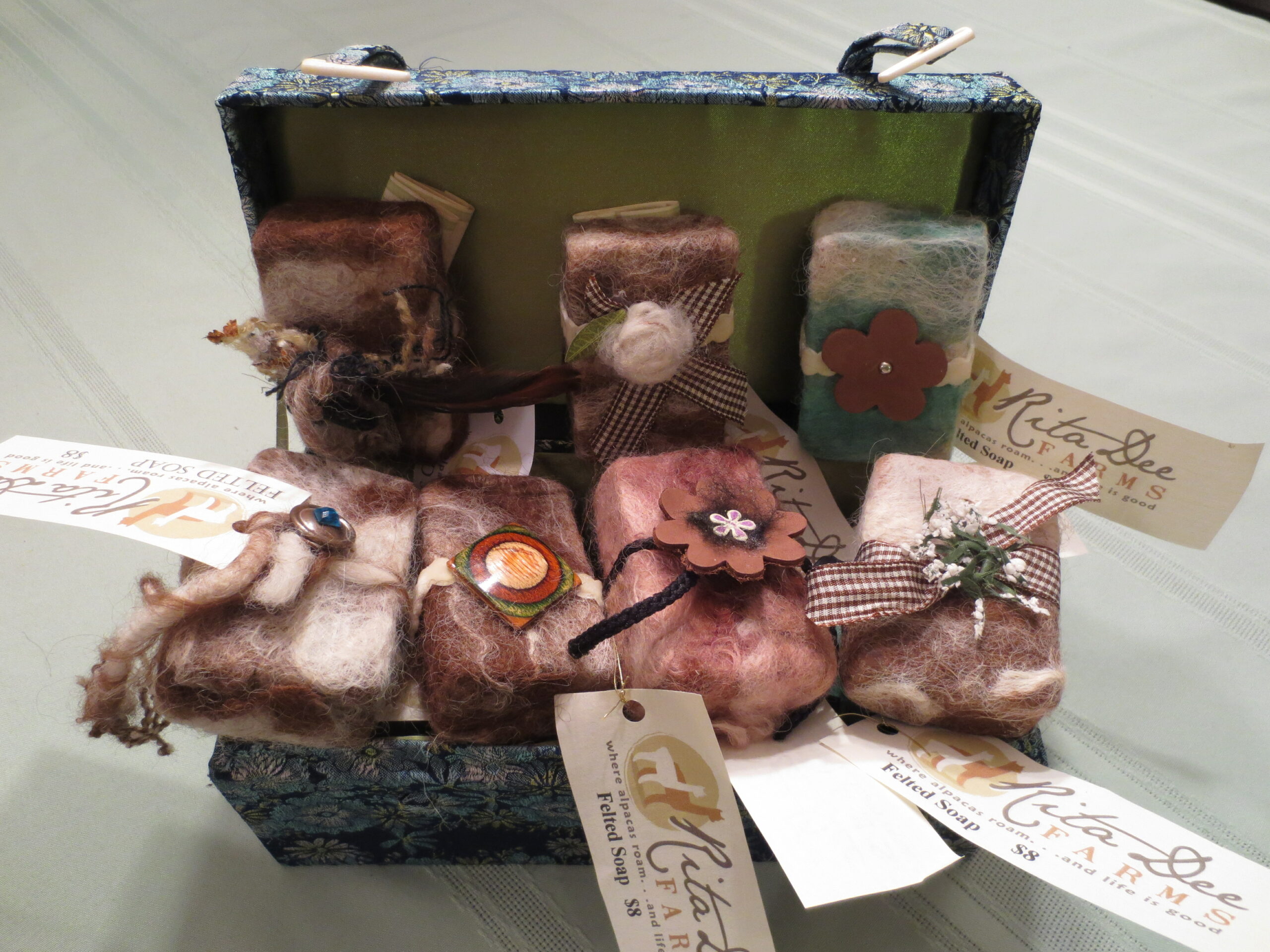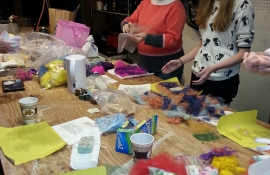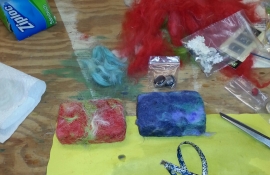Author Archives: admin
Are Alpacas Intelligent You Might Ask
Alpacas are intelligent animals, very communicative and trainable. Our herd understands hand signals and knows a dozen or more verbal commands. They are all halter trained and do very well when in the show ring, on shearing day and during herd health. Other farms are known to train their alpacas for maneuvers through obstacle courses.
We have observed our alpacas to have a keen sense of sight and hearing. They will turn to the road when they sense someone is coming and often it is several minutes before we are able to see or hear anything! Our alpacas also use their lips to move feed dishes. If our feed dishes are stacked where they can get to them, they will lip each one, unstacking them one by one to check for feed left in dishes. They also use their two-toed padded feet to kick over dishes to get to their favorite grain or scramble up a fresh pad of hay to find the best grass selections. They show a bit of intuitive thought when we water bellies by moving and jumping in front of other alpacas to make sure they receive the most water. Some will twirl in front of the hose to make sure they get well soaked on all sides. The most amazing observation was this winter is once when the outside water bucket was iced over. Pistol picked it up with his lips and dropped it several times trying to break the ice.

If visiting our farm, you may observe alpacas use their keen sense of smell to smell the top of your head or your breath to get to know you. We usually must explain to our visitors how alpacas do not understand personal space but do know when a visitor is friendly and knows you when you come back to visit. They have a 6th sense that tells them when someone is in need. For example, Susie Q has cushed (a particular style of laying down) on three occasions to allow a visitor to sit with her and pet her. They also know when someone is unfriendly or a threat. Once a model was here for a photo shoot who professed to disliking animals: Guess what, we could not lead one alpaca to her!
Come enjoy a private tour with us where you will discover your abilities to communicate with the alpacas and tune-up your alpaca whispering skills. By the way, most alpacas in our herd do not mind walkers, wheelchairs and strollers.

When To Visit Our Alpaca Farm
Have you ever been to the zoo in the middle of the summer and ask yourself, “Where are all the animals?” And the answer is…they are off somewhere trying to stay cool! That is what you will say if you visit our alpaca farm in the middle of a hot summer day. Heat stress can be a problem for alpacas, so we do what we can to keep them cool. This includes lots of shade, fans, and water. We add electrolytes to at least one of the barn water buckets to replace what alpacas lose through the sweating process. We also keep hay in the barn to prevent them from having to venture out in the heat unnecessarily.
Alpacas also have their own way of regulating heat through their thermal vent or ventral window which is located on the belly side of the animal (from arm pit to arm pit). Here, air flowing low to the ground assists in releasing body heat. If we hose their bellies down to accelerate this process, they are likely to go out to pasture and lay with their bellies to the sun and do what appears to be “sunbathing”. They are letting the breeze continue to cool them down.
There is a formula for calculating the potential heat stress for any given day. Temperature plus percent humidity equals the heat stress Index (HIS). If this value is greater than 150 is our warning sign. Greater than 180 is downright dangerous.
Although we have a weather station here on the farm, I am not one to run and calculate for heat stress, so the rule is: “Keep the farm extremely zin during the summer months”. That means, as little handling as possible. We prefer, no transporting, no haltering, no breeding (of course) and no pasture changes. Two new options we are considering this year are, no fall breeding so females do not have to carry during the heat of the summer and a second shearing for a couple of the extremely dense boys that show signs of heat stress every year.
According to the Climate Survey for North Carolina, 2020 was the 2nd wettest year on record for the state, the 3rd hottest year, AND the first time in 126 years that both precipitation AND temperature were in the top five. You can read more at https://news.ncsu.edu/2021/01/2020-weather-year/.
So, all this to say, we hope you choose to visit our farm at a time that is most convenient for you, but if it is during the heat of a summer day, you may have to visit our alpacas in their “natural habitat”, the barn! Here is another hint: Alpacas look so much more adorable in full fleece, that is, before shearing day. For us, shearing is usually the fourth weekend in April.
A special day at a special school
One of the most amazing things that the alpacas have been able to do is putting smiles on faces, and helping people that have challenges. Pet therapy is well documented using alpacas (one such site is: 8 Amazing Therapy Animals) . Rita Dee Farms was fortunate enough to get a wonderful opportunity to visit The Special Children’s School . The faces glowed from the students to the adults! Such a great time.

My search for the mysterious dung beetles is over.
With shovel in hand, I dug deep in the alpaca pasture yesterday, were I saw any obvious beetle holes thinking it would be their current habitat. Unfortunately, all sites were abandoned. So, I waited until I found fresh soil sitting like an ant hill by one of the holes and started to dig. What an amazing find. I’m sure dung beetles have been a part of this Carolina landscape for quite a while. There are huge deer populations in this area, and it is herbivore feces they crave. It wasn’t until I started poop scooping that I notice the evidence of their existence, but never once have I been able to get a glimpse of one. Dung beetles are nocturnal. They live in the underworld during the day and only come out to play at night.
There are also three types—rollers, dwellers and tunnelers. The little guy I discovered is a rollers. I figured, since alpaca poop came in nice little bean size packages, they could save themselves the trouble of rolling. No, they continue to roll until they have a “bigger than a golf ball” size package for them to feast on at a later time and feed their babies. You won’t find much research on dung beetles and their relationship with an alpaca farm. Research has only been done with beef, dairy and swine. However, I can tell you, these little jewels aerate the soil, help to decompose at a much faster rate, and add nutrients deep into the soil.
Since I have rollers, I don’t have to worry that I might damage their habitat when raking or vacuuming the pasture. If you have dwellers, you wouldn’t want to disturb those areas. Also, of great interest to me is, Ivomectin, the drug most alpaca farmers use to worm monthly as a preventative against Meningeal worm, will kill an dung beetle dead! I plan to keep the environment around this farm free of pesticides, so they can prosper.
The scientific name of this beetle shown here, will remain nameless until I know for sure what he is. I posted on Instagram saying he was Dichotomius Carolinus because of his prominent striations. Sorry for the misinformation. Come to find out, D. Carolinus is not a rollers…so, back to the drawing board. Anyone care to make a more intelligent guess? I’m leaning toward Geotrupes blackburnii.

Pest Eliminated With A Little Help From Our Friend The Parasitic Wasp
Pest Eliminated With A Little Help From Our Friend The Parasitic Wasp
Rita Dee Farms is trying to do our part to ensure we preserve the amazing ecosystem that has developed since we started our alpaca farm. This will be our second year in using Fly Eliminators to manage pest flies. This is done by purchasing a monthly supply of hatching parasitic wasps from April through September that feed upon and breed within developing (pupal) stages of flies, eliminating the adult pest fly. The adult female fly lays her eggs wherever there is decomposing organic matter. Within a short period of time, the microscopic larvae (maggot stage) burrow into organic matter and eventually develop into pupae (cocoon stage).

Fly Eliminator
The female Fly Eliminator is a gnat-sized parasitic wasp which seeks out her host and deposits her eggs inside fly pupae. These eggs begin to grow and feed on the developing fly, thus stopping the adult pest fly from hatching. Fly Eliminators reproduce in 2 to 3 weeks, constantly reinforcing the beneficial insect population.
Unfortunately, flies reproduce at a faster rate than Fly Eliminators; therefore, they must be replenished on a regular basis. We purchase our management program from Arbico-Organics, a company that has focuses on natural solutions that will not harm the environment for over thirty years.
Click here to get more information about fly eliminators. The site features horses, but these eliminators work on all livestock.

Wet Felting
On Saturday some great ladies got together, and learned how to use wet felting to make designer felted soap. Using homemade soaps made by Melisse Hopping and her husband, workshop attendees made their beautiful felted soaps. Be on the lookout for future workshops, including online workshops that will be accessible from the website!
Special thanks to all those attending, including Tammy Limer from Borderline Farms, Lyn Kessie from Keepsake Aplacas, Melinda Liles, Melisse Hopping (for hosting and soap!) from Vinca Hill Fiber Company, plus all the others that took the workshop. It was a lot of fun!
If you are interested in hosting this event at your house, email us! We will be glad to arrange a wonderful wet felting workshop. Enjoy these pictures from the event.

Alpacas for Sale
We have beautiful alpacas that are available to purchase! They are a great addition to your farm, or help you start a farm of your own. Visit our farm for more information.




